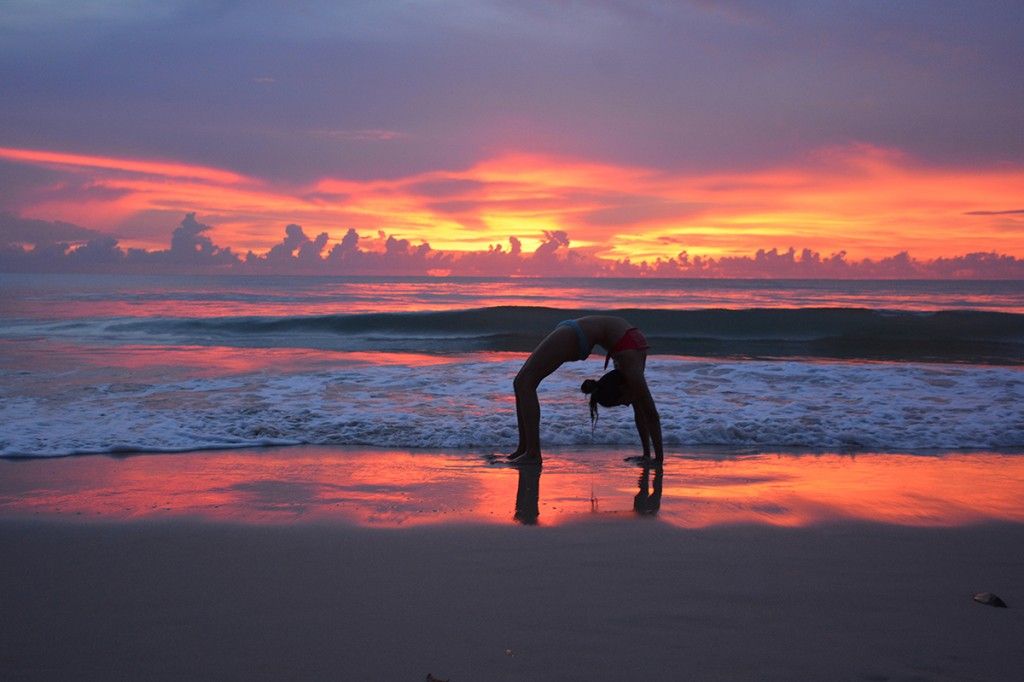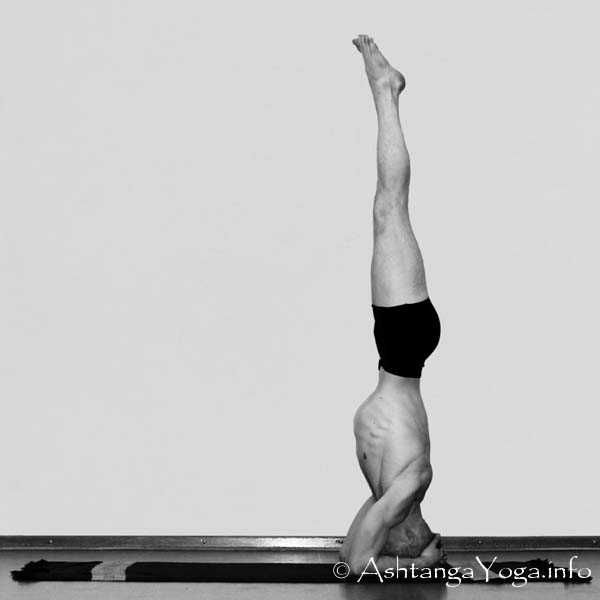A Yogini and a Passed Out Puppy ~ Starring Liz Arch & Chai Sturman from Robert Sturman Studio on Vimeo.
Many people understand that a daily yoga practice leads to a more enriching life. When we practice, we feel better. We are more in tuned with our senses, with our friends and family, and with the world at large.
The problem many of us have is actually having the willpower to wake up each morning and literally “Do our yoga practice.”
When we’re lying in bed in the morning, our minds have a funny, nagging way of convincing us that it is better to stay in bed and that “doing our practice” is not necessary. Our minds will come up with any sort of excuse. “You’re too tired, you need to clean your room, it’s too cold outside, it’s too hot outside, need to let the dog out, etc.”
Your mission is to transcend these excuses and hit the mat every day. Each time you succumb to excuses, you are losing a bit of willpower. Each time you do your practice, even if it is a short practice, you are making a deposits in the willpower bank.
When a friend is coming to pick you up for yoga practice or when a friend is relying on you to pick them up for yoga practice, you are less likely to make up excuses and miss practice. When you’re only letting yourself down or lying to yourself, it is easier to succumb to excuses. If your friend has gone out of their way to pick you up for practice, are you going to lie in bed and make up excuses? Find a friend, rely on each other, and don’t let each other or yourselves down!
A common excuse while lying in bed is, “Oh, I’m not going to get up because I need to get up and find clothes and gather my yoga mat. That’s too much effort, I’ll just continue sleeping.” Eliminate this obstacle by placing your yoga mat and a bag with yoga clothes next to your bed or door. This creates one less excuse for your mind to concoct.
If your asana practice is a home practice, lie your mat on the ground before you go to sleep the previous night. That way, you can literally roll out of bed and do your practice.
To take this a step further, if you practice with incense or music, have the incense in a ready position so that all you need to do is light it. Have your music cued the night before so all you need to do is press “Play.”
Seems like a small/obvious tip, but it really works!
It’s difficult to go from doing zero practice to full asana practice every day. A common mistake we make is trying to achieve too much in too short of a time frame. When we set lofty goals that are difficult to attain, we end up missing them and thus losing the all important willpower that we set out to achieve.
If you’re starting at zero practice, set a goal to practice 3 times a week for five minutes. Once you’ve achieved this successfully, slowly build up. Keep making deposits in the willpower bank 🙂
Rory wrote a great post here on lighting tapas.
Ask a friend to text, call, or email you every day around 10am asking one simple question: “Did you practice today?” If you’re making up excuses having an accountability partner will make this more apparent. It’s important not to get frustrated by these messages, understand that your friend is helping you out of love, looking out for your best interests by forcing you to be honest with yourself.

While a YouTube yoga video is certainly not necessary, it is helpful for beginners or those who are having difficulty building willpower.
I have several “go to” routines. One is Pattabhi Jois’ Led Primary Series. The other is for when I have less time. When I have only 5~20 minutes, I put this short led yoga with Kirtan music on and do Sun As followed by Sun Bs, and keep flowing wherever my practice takes me. Always leave at least five minutes for Savasana.
Here are a few other yoga YouTube videos that I’ve enjoyed:
David Swenson’s short form Ashtanga 15 minutes
David Swenson’s short form Ashtanga 45 minutes
Pranidihi Varshney short form Ashtanga
The 5 Tibetan Rites by Raageshwari
It is important to be realistic and admit that sometimes you will not have time to do a full practice.
Remember that hitting the mat for even one minute each day is far better than not hitting it at all.

Just get up and practice 🙂
There’s no substitution for looking yourself in the mirror and making a commitment. Tell yourself, even affirm out loud, “I am going to practice asana today. No excuses.” A few days of this and boom…. you’ve created a long lasting habit that sticks.
Remember, as the late Krishna Patabhi Jois rightly said, “Do you practice and all is coming.”
This is a 22 minute practice for anyone with an injury, a limited amount of time, or a preference to start their day with deep breathing & presence but not intensive asana postures.
Take time for yourself.
Be kind to your body.
Enjoy and let us know what you think 🙂

Danielle practicing Urdhva Dhanurasana ( Wheel Pose ) at sunset in Thailand.
Overcoming Asana has a very detailed piece on jumping back in Ashtanga Yoga. I encourage all yoga practioners to read it when they have the opportunity.
“Iyengar talking about his guru Krishnamacharya in an interview from the movie Enlighten up.
Iyengar is focusing on the ‘jumping’ aspect of Krishnamacharya’s teaching and explaining it as a result of Krishnamacharya teaching the warrior class boys of the Mysore palace. Practice as exercise, as fitness, somewhat akin to a ‘martial art’.
Your heels may never touch the floor in Downward Facing Dog. It isn’t a hard and fast rule. This pose is a spine lengthener, and you want to use your arms and legs as a way to support the actions of lengthening the spine while keeping the hips and shoulders in alignment. Sometimes, your stance may be too long causing the heels to lift. Sometimes, tight hamstrings, lower back muscles or feet can cause the heels to stay lifted. The main idea is to find alignment thus allowing your body’s innate system of reducing stress to activate.
Via Athleta
Oh, chaturanga dandasana. We’ve had a long and complicated relationship. I remember my first few yoga classes way back when, and how it was unclear to me that people were not in fact lowering themselves all the way to the floor. They were – gasp – hovering! And when I first tried you, how miserably I failed. You may not come easily, chaturanga, but perseverance pays off.
There is nothing like supporting your own body weight for building strength. Which is why you must not do a drive-by with this pose, cruising as fast as you can into upward facing dog. As Baron Baptise puts it in his book Journey Into Power: “A lot of students try to sneak their way past Low Push-Up and move directly from High Push-Up to the next pose, which is Upward Facing Dog, but I strongly encourage you not to do this. Find ways to work within the pose. Modify, dilute, research, but don’t run or avoid the work. Challenge yourself sensitively and your weakness will soon turn to strength.”
Read the full guide on how to do chaturanga dandasana properly.
Image via Athleta
Some beginners tell me that the Downward Facing Dog position is not relaxing or comfortable for them. Several clients describe pain in their wrists and shoulders. These 4 tips can help put you at ease with one of the most common yoga poses:
Softening The Shoulders
Putting all of your weight in to the upper body and mostly in the shoulders will cause you to fatigue quickly in this pose. It is also causing tightness to be created there when it should be that we are creating space. Relax the shoulders down and away from the ears. Try to pull the shoulders back and down to release any tension.
Gazing Directly At The Big Toes
In my classes I see a lot of beginners looking straight down at the mat or towards their hands while shifting to downward-facing dog. This makes it hard to distribute the weight evenly in to the lower and upper body. Holding a slight gaze towards your toes causes the neck to relax and stay line with the spine.
Click to read two more tips on how to improve your adho mukha svanasana.
Via DoYouYoga

Sirsasana or headstand is one of my favorite postures, and has been for many years. There was a time when I would request a headstand on every class I went to whenever the instructor asked us what we wanted to work on. To this day, I practice headstand for at least 10 minutes, 6 days a week.
This posture may seem like just a fun party trick, but it is actually so much more. The health benefits of headstand and its variations are many.
Before you begin, remember that while you are learning head stand it is best to practice with a teacher until you find your bearing. This posture is healing, but only if you are doing it properly and safely. If you have any neck or back issues, you will most likely want to skip this posture until you are recovered. It is also commonly advised not to go upside-down if you are on your moon cycle or pregnant. If you have a healthy neck and back and know this pose, here are my top ten health benefits of Headstand!
1. Relieves Stress
Headstand is known as a cooling posture, meaning that it helps you to draw your attention inwards. This posture is extremely helpful if you are having anxiety, stress, fear or otherwise worrisome thoughts. Combine headstand with long, slow breathing and you have a recipe for stress relief.
2. Increases Focus
When you turn upside down, you are increasing the blood flow to your brain. This can help to improve mental function, and increase you sense of focus.Along with helping to reduce fear and worry, this posture will improve your ability to keep your mind sharp and clear.
Click to eight more reasons why headstand is an incredible asana — YOGA.